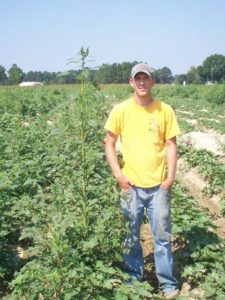In perennial fruit crops, the orchard or vineyard floor is often divided into two distinct zones. Within the planted row portion of the field, weeds are managed- typically with herbicides. The between-row spaces or “row middles” consist of planted grass or native vegetation and facilitate the travel of equipment. Determining where the two zones meet[Read More…]
The newest version of the SelectMax® herbicide label includes a change relevant to the state’s fruit growers. Previously limited to applications in non-bearing pome fruit crops, the newest label allows applications to be made to bearing pome fruits. The active ingredient in SelectMax® is clethodim, one of the commonly used grass-selective herbicides. Pome crops covered[Read More…]
Dual Magnum is registered for use in numerous row crops and specialty crops in the state of Indiana. While some vegetable crops (beans, peas, potatoes, pumpkins, rhubarb, and tomatoes) appear on the specimen or national label (Section 3 label), fruit crops do not. Numerous specialty crops that do not appear on the specimen label are[Read More…]
Spring is here and with it comes the emergence of weeds- especially problematic perennials like Canada thistle (Figure 1). Many weeds in perennial fruit crops are controlled during site preparation, but can become problematic again after crop establishment. Below is some information about Canada thistle and methods to manage it. Keep in mind two things:[Read More…]
Early spring is a good time to make the first herbicide application of the year in fruit plantings where a weed-free strip is maintained in the row (Figure 1). There are several options for fruit crops including both pre- and post-emergence herbicides. See the weed control chapter in the 2019-2020 Midwest Fruit Pest Management Guide[Read More…]
In an October 2019 Hot Topics article on the Facts for Fancy Fruit website, I referenced the new regulatory changes to herbicides containing the active ingredient paraquat. One of the new requirements is for closed system packaging. To quote the Environmental Protection Agency (EPA): “New closed-system packaging (is) designed to prevent transfer or removal of[Read More…]
As the production season winds down there are two weed-related news items that producers should be aware of: New Requirements for Users of Paraquat Herbicide. Paraquat dichloride is the active ingredient in products such as Gramoxone, Devour, Cyclone, and Quik-Quat. Earlier this year the Environmental Protection Agency (EPA) announced the following changes to paraquat requirements:[Read More…]






